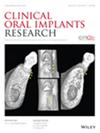预防种植周炎的临床趋势:西班牙牙周病学会(SEPA)基金会使用德尔菲法进行调查
IF 5.3
1区 医学
Q1 DENTISTRY, ORAL SURGERY & MEDICINE
引用次数: 0
摘要
目的采用德尔菲法进行两步调查,评估预防种植体周围炎的临床趋势。材料和方法由西班牙牙周病学会(SEPA)挑选的一组年龄在45岁的参与者被要求回答一项由指导委员会准备的75项陈述的调查。项目分为5个主要领域:发病机制和流行病学,手术、种植体和假体相关因素对种植体周围炎发病/进展的影响,以及自我和专业管理的口腔卫生。报告参与者之间的同意或不同意程度。结果总共有44位受访者对参与调查表示赞同。在拟定的75项声明中,第一轮达成协议的有35项(46.7%)。在未达成共识的40项声明中,有16项(40.0%)在第二轮中达成一致。总的来说,75项声明中有51项(68.0%)在第二轮达成了共识。其中,同意36人(48.0%),不同意15人(20.0%)。研究种植体周围炎的手术相关因素和假体相关因素的部分产生了最高水平的冲突(9/18和8/14的陈述分别显示了不确定的一致性)。在关于种植体周围炎和种植体相关因素的发病机制和流行病学部分,大多数项目达成了共识(分别为14/17和10/13)。关于自我管理和专业管理口腔卫生的部分获得了最高的共识,只有1/13的项目在参与者中显示不同意见。结论:本研究的结果显示,70%的评估结果与预防种植体周围炎的临床趋势一致。本文章由计算机程序翻译,如有差异,请以英文原文为准。
Clinical Trends in the Prevention of Peri‐Implantitis: Spanish Society of Periodontology (SEPA) Foundation Survey Using the Delphi Method
ObjectiveTo assess clinical trends to prevent peri‐implantitis in applying a two‐step survey based on the Delphi method.Material and MethodsA panel of participants aged < 45 years old selected by the Spanish Society of Periodontology (SEPA) was asked to answer a survey with 75 statements prepared by a steering committee. Items were divided into 5 major areas: etiopathogenesis and epidemiology, surgical, implant, and prosthetic‐related factors on the onset/progression of peri‐implantitis, and self‐ and professional‐administered oral hygiene. Degree of agreement or disagreement among participants was reported.ResultsIn total, 44 participants responded favorably to participate in the survey. From the 75 statements formulated, 35 were agreed on in a first round (46.7%). From the 40 statements that did not reach consensus, 16 were agreed on in a second round (40.0%). Overall, 51 out of 75 statements (68.0%) achieved consensus in a second round. From these, 36 (48.0%) were in agreement, while 15 (20.0%) were in disagreement. The sections that explored surgical‐related factors and prosthesis‐related factors of peri‐implantitis yielded the highest level of conflict (9/18 and 8/14 statements demonstrated indeterminate agreement, respectively). In the sections on the etiopathogenesis and epidemiology of peri‐implantitis and implant‐related factors, most items reached consensus (14/17 and 10/13 items, respectively). The section on self‐ and professional‐administered oral hygiene obtained the highest level of consensus, with only 1/13 items showing dissent among the participants.ConclusionThe results of this study on the clinical trends in the prevention of peri‐implantitis showed consensus agreement for ∼70% of the statements evaluated.
求助全文
通过发布文献求助,成功后即可免费获取论文全文。
去求助
来源期刊

Clinical Oral Implants Research
医学-工程:生物医学
CiteScore
7.70
自引率
11.60%
发文量
149
审稿时长
3 months
期刊介绍:
Clinical Oral Implants Research conveys scientific progress in the field of implant dentistry and its related areas to clinicians, teachers and researchers concerned with the application of this information for the benefit of patients in need of oral implants. The journal addresses itself to clinicians, general practitioners, periodontists, oral and maxillofacial surgeons and prosthodontists, as well as to teachers, academicians and scholars involved in the education of professionals and in the scientific promotion of the field of implant dentistry.
 求助内容:
求助内容: 应助结果提醒方式:
应助结果提醒方式:


